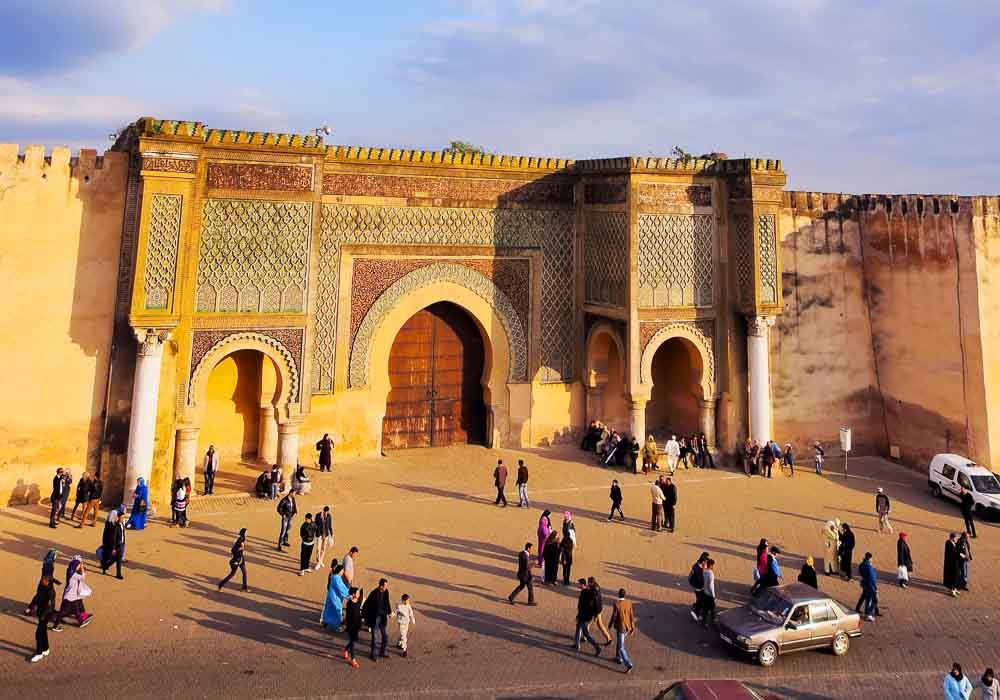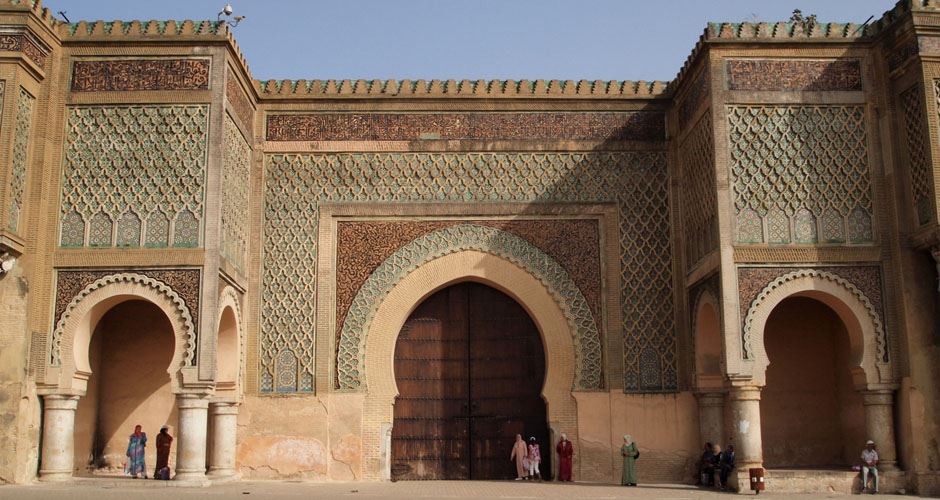Meknès

Ofen called and Versailles of Morocco and quieter and smaller than its grand neighbor, Fez, Meknès is laid-back and relatively hassle-free, yet filled with winding medina streets and grand buildings that harken back to its history as an imperial city and one-time home of the Moroccan sultanate. Sultan Moulay Ismail, the city’s primary architect, planned the city magnificently, with three sets of fortifications ingeniously incorporated into the road networks. The king’s tomb sits at the heart of what remains of the imperial city, flanked by a royal granary and the spectacular Bab el-Mansour and Place el-Hedim.
The Bab el-Mansour, a huge gate in the Place el-Hedim, is the grandest of all imperial Moroccan gateways. The gate is well-preserved, with lavish zellij (mosaic tilework) and inscriptions (reading “'I am the most beautiful gate in Morocco. I am like the moon in the sky. Property and wealth are written on my front”) across the top. Completed by Moulay Ismail’s son, Moulay Adballah, in 1732, its two white columns on either side are made of Corinthian marble plundered from a Marrakech palace. Place el-Hedim constitutes the heart of the medina (old city), originally used for both royal announcements and public executions. Here, there’s something always going on to watch: kids playing football, musicians playing, and promenading families treating their kids to spins in electric toy cars.
Overlooking Place el-Hedim is Dar Jamaï, a palace built in 1882 by the powerful Jamaï family, two of whom were viziers to Sultan Moulay al-Hassan I. Since 1920, the palace has housed a fine museum of traditional ceramics, jewellery, textiles and cedar-wood craft dating from the fourteenth century. The museum’s Andalusian garden and courtyard are shady, peaceful spots amid overgrown orange trees, brimming with bird life—the crumbling palace and gardens are well worth the admission fee in their own right. Look out for the brocaded saddles, and some exquisite examples of Meknasi needlework (including some extravagant gold and silver kaftans). The koubba (domed sanctuary) upstairs is furnished as a traditional salon complete with luxurious rugs and cushions. The museum also has some antique carpets, representing various styles from different regions of Morocco.

South of Bab el-Mansour lies the mechouar (parade ground), now known as Place Lalla Aouda, where Moulay Ismail inspected his famed Black Guard. After bringing 16,000 slaves from Sub-Saharan Africa, Moulay Ismail guaranteed the continued existence of his elite units by providing the soldiers with women and raising their offspring for service in the guard. By the time of Moulay Ismail's death, the Black Guard had expanded tenfold. Its successes were many, ranging from quelling internal rebellions, to chasing European powers out of northern Morocco, to disposing of the Ottoman threat from Algeria.
Be sure not to miss the final resting place of the sultan who made Meknès his capital in the seventeenth century, the Mausoleum of Moulay Ismail. As of 2016, the site closed for much-needed restoration work, but it is expected to reopen in 2018. The tomb hall is a lavish celebration of the best of Moroccan craftsmanship.
Little visited but rather glorious in its semi-state of repair, Palais Al-Mansour is an all-but-forgotten relic of Moulay Ismail's reign, in a quiet suburb of Meknès. The seventeenth-century palace was once the king's summer residence, built by the same architect who master-minded Bab el-Mansour. The round, domed reception room – architecturally magnificent with seven arches, but restrained in every other way, typical of Moulay Ismail's distinctive style – is a highlight. From the roof, the ruins of the residential palace rooms are open to the elements and the Imperial City can just about be spied from the balconies fronting the palace.
The Koubbat as-Sufara’ was once the reception hall for foreign ambassadors and here UNESCO chose to place its World Heritage inscription when the city was designated in 1996. In front of the building is a broad clearing pock-marked with small subterranean windows providing light for a vast forty-hectare crypt of similar construction to the granary at Heri es-Souani. The dark and slightly spooky network of rooms below ground was a mystery when discovered. Historians now believe it was used for food storage, although tour guides will delight in recounting the (erroneous) story that it was used as a dungeon for the Christian slaves who provided labour for Moulay Ismail’s building spree.
Nearly two kilometers southeast of Moulay Ismail’s mausoleum, stand the ruins of Heri es-Souani, the king’s immense granaries and stables. Ingeniously designed to keep temperatures cool and air circulating, the building houses more than twelve thousand horses.

